Considering the placement in a tokonoma
by Mr.Paul Goff
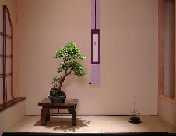
My English friend Paul Goff, bonsai enthusiast, provides us with an article published on the book by Craig Coussins "Bonsai Master Class" about the display of a bonsai in a tokonoma. In the article special attention is given to the choice of illustration in the scroll, depending on the season and on the bonsai and some considerations are undoubtedly valid also for suiseki. Paul is also the author of the scrolls : he realizes both the scroll and the illustrations, in various formats, even for the fans, so they can choose the size and the subjects they wish. In addition to shikishi, tanzaku and relative supports, Paul also realizes real Kakejiku.
Paul will soon publish a new book, devoted entirely to the tokonoma display.
(Thanks friends Mr. Paul Goff and Mr. Craig Coussins for allowing the publication of the article).

|
|
Considering the placement in a tokonoma
Paul Goff |
A single falling leaf in the wind
and rain clearly describes fall
with this Scot's pine. |
|
|
| |
|
|
The basic intention when displaying bonsai should be to hold the viewer's attention while conveying an overall feeling of harmony. If more than one object is included in the display, i.e., a bonsai, table, accent plantings, figurines, stones, or hanging scroll, it is appropriate that the items bear relevance to one another, and that the artist uses them in a minimal way to convey an understanding of a particular time, place, or season in the natural landscape.
Whether the arrangement is on exhibition benching or in a specially designated display alcove (tokonoma), the artist must employ a measure of sensitivity in terms of spacing, size, and proportion between the elements to ensure that a well-balanced, harmonious living picture is achieved that delivers a positive message to the viewer.
The placement of such an arrangement must be carefully considered. At an exhibition, individual spaces are often defined by lengths of bundled bamboo on a bench at a convenient viewing height for standing spectators. A plain background is essential, and the designated space must then be perceived as a frame for the intended picture.
The use of tokonoma allows the artist to organize his or her display without distraction in a specially constructed alcove or niche. Neutral or earth colors are normally combined with natural timber in its construction. A small tokonoma of less than 3 feet (1 m) in width may be elevated to a convenient viewing height, while a larger space, up to 10 feet (31 m) in width, is often set lower for seated contemplation.
|
|
| |
|
|
 |
| This mountain pine changes little throughout the year, but by employing a neutral scroll, the mood and season can be implied by thoughtful use of illustrations. |
|
|
|
The Western preoccupation with clutter must be avoided at all costs when making an artistic arrangement. A simpler, minimal statement, using three or fewer objects, is preferred. In fact, some will argue that, if any one of the objects is removed and the story remains the same, that object was not essential in the first instance. In other words, bonsai with accent-planting, bonsai with scroll or bonsai with suiseki, or any combination of two to three of the aforementioned components, may be sufficient. The restricted number of elements will, it is hoped, stimulate the spectator at an intellectual level to unravel the relevance of the objects in terms of their association, in order to reveal the artist's intended picture.
To aid the artist in getting his or her message across, it would be wise to study some established guidelines. To be bound by hard-and-fast rules would be foolish, and may result in the restriction of uplifting artistic playfulness.
Look, listen, and learn from successful displays and arrangements and, of course, observe our greatest teacher, nature itself. When placed in a restricted setting, a bonsai with any added accessories will set up a degree of correspondence between those items. Here, relevance is paramount. If an appropriate association does not exist, a unified composition of beauty and harmony will not emerge. The opportunity for an exhilarating moment is then lost. It is not difficult, but it must be thought out and planned well. As with other tasks associated with the creation of bonsai, preparation proves invaluable.
Proportion and spacing between the items in the display deserves important consideration in order to retain a harmonious unity of oneness, yet creating the illusion of great depth and spaciousness. No one piece should dominate the arrangement, and the visual movements of the individual pieces should ultimately focus the viewer's attention to the center of a scalene triangle linking the visual centers of the bonsai, scroll, and accent components. These points of the triangle may also be seen as representing heaven at the top, man at the mid-point and the earth at the base.
|
|
|
 |
| An icy, cold moon on the hanging scroll confirms a winter setting for this English oak. |
| |
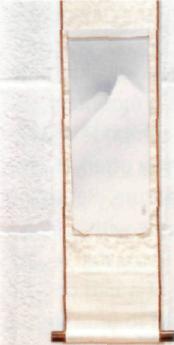
.jpg) |
This simple arrangement of snow-covered mountains and
a snowdrop tells of a cold day
toward the end of winter. |
|
|
So what observations and guidelines should we consider? If you decide to follow Japanese traditional bonsai display, it will become necessary to understand the categories of shin, gyù, and sùu, which mean "formal," "semi-formal," and "informal." Each category can be broken down into further subdivisions of shin, gyù, and sùu, resulting in a very specific arrangement; for example, shin gyù (a formal bonsai set in a semi-formal way). The tree, being the key subject in the display, determines the style, i.e., formal, semi-formal, or informal. Special occasions, times of celebration or the reception of an important guest may be acknowledged by setting a formal or shin display in the tokonoma. A formal-upright pine, juniper or yew in a rectangular pot with vertical sides is considered appropriate here, and traditional elements that are also suitable for the occasion may be included as accent, accessory, or scroll.
A semi-formal, or gyù, display would feature an informal bonsai as its centerpiece. This may be a deciduous or flowering tree in a pot with softer, curved lines. The gyù display is ideal for identifying the season.
The informality of the sùu display allows the more free-form approach, and may include literati or cascade bonsai styles. Here, it is appropriate to express the season or simply the mood and atmosphere.
Basic considerations for setting out an individual display at an exhibition or in a tokonoma will usually begin with a bonsai as the centerpiece, although this is not always the case, as suiseki or kusamono can often be prime subjects. The artist must decide if the display should convey a special occasion or the mood of the location at a particular time of day or season. When considering the season, ideally, a subtle hint of nature's progression toward the coming season should be included. With the combination of no more than three objects, plus the power of suggestion, it should be possible to influence the spectator in his or her understanding of your intent. It is crucial that, as the exhibitor, you avoid any degree of repetition in terms of materials, finishes, and colors in the content of your arrangement. For example, to include dwarf flowering alpines as accent in a glazed pot in association with a flowering bonsai also in a glazed pot would be considered inappropriate on two counts: the repetition of glazed containers and the presence of flowers in two instances.
|
|
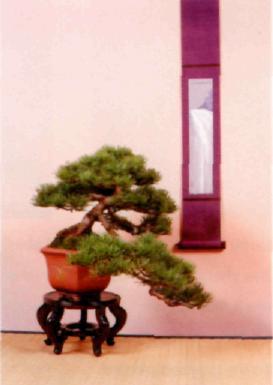 |
| At the end of winter, melt waters come rushing down from the mountains — a perfect accompaniment for this mountain pine. |
| |
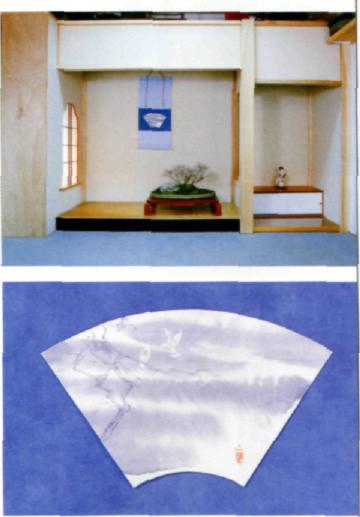 |
| Courting doves on the hanging scroll enhance the joys of spring with a flowering-cherry group bonsai. |
| |
| |
| |
| |
| |
|
|
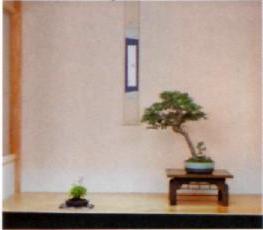 |
|
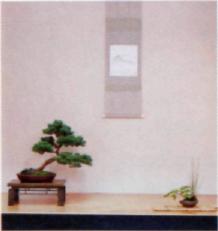 |
|
 |
|
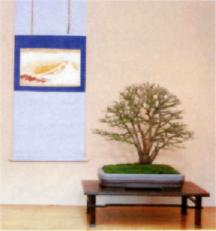 |
|
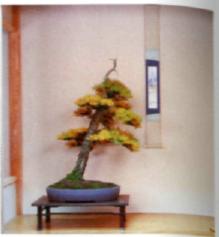 |
|
A scalene triangle should link the visual centers of the scroll, bonsai, and accent. Here, a common hawthorn is accompanied by an accent of feverfew and a single butterfly on the scroll — the perfect summer day.
|
|
Lakeside summer — a Chinese juniper leans over the water's edge, while rush grass with blackberry occupy the boggy shore. Being set on a bamboo raft stand accentuates a waterside theme. On the scroll, a single boatman is spotted in the mist on the lake.
|
|
A winter dump of English elm stands before a snow-covered peak, while snowdrops indicate warmer days ahead. Here, we can clearly see how depth is created in the display by placing the accent slightly forward of the key object.
|
|
Fall lakeside with a European larch — the scroll implies a setting in the hills, shortly after a rainstorm. The accent is miniature geranium.
|
|
 |
|
 |
| On the scroll, an owl flies past a golden moon; it may be nesting in the hollow of the field maple. Here, the accent comprises a continuation of fallen leaves fronm the bonsai and the emergence of fall fungi on the piece of old tree stump. |
| |
 |
| The rising-sun theme on a scroll and a stork as the accessory would make ideal companions to a formal-upright, evergreen bonsai in a New Year display. |
|
|
|
Similarly, a rock planting as the main subject would not sit well alongside a suiseki as accent, or even a scroll painting that includes a mountain landscape, because of repeating themes. Links between component parts of the display must be made by subtle implication, and may often involve intellectual interpretation by the spectator to reveal the picture. Returning to the rock-planted bonsai, the accent could be alpine grass with a container that is totally unlike that of the centerpiece to imply the location of trees and rocks at altitude, or even a figurine of a bird or animal found in this environment. The scroll could be used to indicate the season by incorporating a flower, grass, an insect, the sun or moon, clouds, or mist, but, in any event, must not illustrate any other element repeated in the arrangement.
The sun and moon are excellent indicators of time and season. The Japanese often use the rising-sun theme for new life or a new beginning in a formal New Year display. The sun seen behind the clouds, or through the mist, may help with time of day, but avoid using a setting sun as this may imply the end of a period or death. A deep-orange or blood-red full moon (harvest moon, as we know it) may suggest late summer/fall.
It is natural to expect that endless variety and numerous combinations of display elements are possible. Therefore, the outline here is simplistic, but, I hope, will inspire the enthusiast to look further into the world of traditional bonsai display.
|
|
|
| |
|
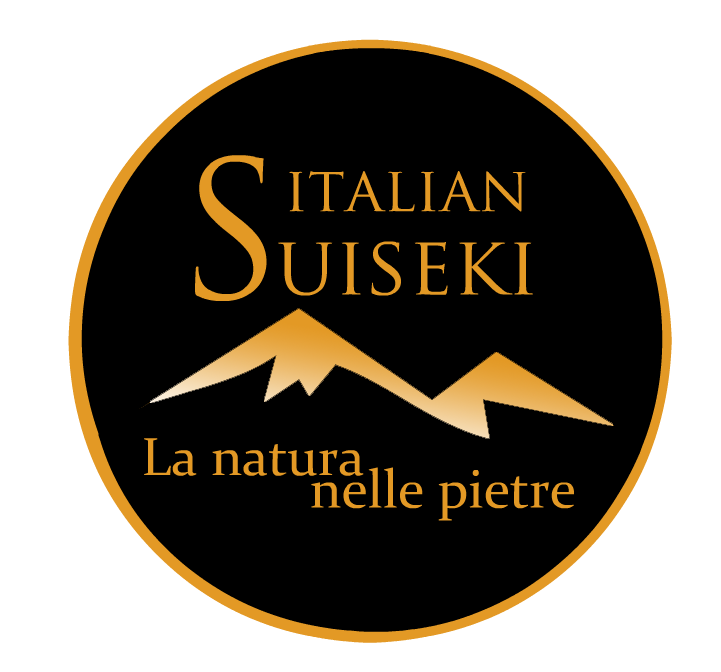





.jpg)










